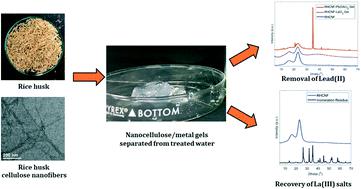当前位置:
X-MOL 学术
›
Environ. Sci.: Water Res. Technol.
›
论文详情
Our official English website, www.x-mol.net, welcomes your
feedback! (Note: you will need to create a separate account there.)
Rice husk based nanocellulose scaffolds for highly efficient removal of heavy metal ions from contaminated water
Environmental Science: Water Research & Technology ( IF 3.5 ) Pub Date : 2020-08-31 , DOI: 10.1039/d0ew00545b Chengbo Zhan 1, 2, 3, 4, 5 , Priyanka R. Sharma 4, 5, 6, 7 , Hongrui He 4, 5, 6, 7 , Sunil K. Sharma 4, 5, 6, 7 , Alexis McCauley-Pearl 7, 8, 9 , Ruifu Wang 4, 5, 6, 7 , Benjamin S. Hsiao 4, 5, 6, 7
Environmental Science: Water Research & Technology ( IF 3.5 ) Pub Date : 2020-08-31 , DOI: 10.1039/d0ew00545b Chengbo Zhan 1, 2, 3, 4, 5 , Priyanka R. Sharma 4, 5, 6, 7 , Hongrui He 4, 5, 6, 7 , Sunil K. Sharma 4, 5, 6, 7 , Alexis McCauley-Pearl 7, 8, 9 , Ruifu Wang 4, 5, 6, 7 , Benjamin S. Hsiao 4, 5, 6, 7
Affiliation

|
Rice husks are an agricultural residue of great annual production and have a high cellulose content. In this study, we have prepared highly charged carboxyl cellulose nanofibers (CNFs) from rice husks using the TEMPO-oxidation method and the extracted CNFs were evaluated as an adsorbent for the removal of lead(II) and lanthanum(III) (Pb(II) and La(III)) ions from contaminated water. Three different forms of nanocellulose adsorbents were prepared: suspension, freeze-dried, and nanocomposite containing magnetic nanoparticles, where their adsorption performance was tested against the removal of the two chosen heavy metal ions. The maximum adsorption capacity of rice husk based CNFs was found to be the highest in the nanocellulose suspension, i.e., 193.2 mg g−1 for Pb(II) and 100.7 mg g−1 for La(III). The separation of the used adsorbent in the suspension was further facilitated by the gelation of the CNFs and metal cations, where the resulting floc could be removed by gravity-driven filtration. The absorption mechanism of the investigated CNF system is mainly due to electrostatic interactions between negatively charged carboxylate groups and multivalent metal ions. It was found that 90% lanthanum content in the form of lanthanum oxychloride (determined by X-ray powder diffraction) could be obtained by incinerating the CNF/LaCl3 gel. This study demonstrates a viable and sustainable solution to upcycle agricultural residues into remediation nanomaterials for the removal and recovery of toxic heavy metal ions from contaminated water.
中文翻译:

基于稻壳的纳米纤维素支架,可高效去除污水中的重金属离子
稻壳是年产量高的农业残留物,纤维素含量高。在这项研究中,我们使用TEMPO-氧化法从稻壳中制备了高电荷的羧基纤维素纳米纤维(CNF),并将提取的CNF作为脱铅(II)和镧(III)(Pb(II)的吸附剂进行了评估。)和La(III))来自受污染水的离子。制备了三种不同形式的纳米纤维素吸附剂:悬浮液,冷冻干燥的和含磁性纳米颗粒的纳米复合材料,其中针对两种选定的重金属离子的去除测试了它们的吸附性能。基于的CNF稻壳的最大吸附能力被认为是在纳米纤维素悬浮液中的最高的,即,193.2毫克克-1对Pb(II)和100.7毫克克-1的La(III)。CNF和金属阳离子的凝胶化进一步促进了悬浮液中使用过的吸附剂的分离,其中可以通过重力驱动的过滤去除所得的絮凝物。被研究的CNF系统的吸收机理主要是由于带负电荷的羧酸盐基团和多价金属离子之间的静电相互作用。已经发现,通过焚烧CNF / LaCl 3凝胶,可以得到90%的三氯氧化镧形式的镧含量(通过X射线粉末衍射测定)。这项研究展示了一种可行且可持续的解决方案,可以将农业残留物升级为修复性纳米材料,用于从污染水中去除和回收有毒重金属离子。
更新日期:2020-09-20
中文翻译:

基于稻壳的纳米纤维素支架,可高效去除污水中的重金属离子
稻壳是年产量高的农业残留物,纤维素含量高。在这项研究中,我们使用TEMPO-氧化法从稻壳中制备了高电荷的羧基纤维素纳米纤维(CNF),并将提取的CNF作为脱铅(II)和镧(III)(Pb(II)的吸附剂进行了评估。)和La(III))来自受污染水的离子。制备了三种不同形式的纳米纤维素吸附剂:悬浮液,冷冻干燥的和含磁性纳米颗粒的纳米复合材料,其中针对两种选定的重金属离子的去除测试了它们的吸附性能。基于的CNF稻壳的最大吸附能力被认为是在纳米纤维素悬浮液中的最高的,即,193.2毫克克-1对Pb(II)和100.7毫克克-1的La(III)。CNF和金属阳离子的凝胶化进一步促进了悬浮液中使用过的吸附剂的分离,其中可以通过重力驱动的过滤去除所得的絮凝物。被研究的CNF系统的吸收机理主要是由于带负电荷的羧酸盐基团和多价金属离子之间的静电相互作用。已经发现,通过焚烧CNF / LaCl 3凝胶,可以得到90%的三氯氧化镧形式的镧含量(通过X射线粉末衍射测定)。这项研究展示了一种可行且可持续的解决方案,可以将农业残留物升级为修复性纳米材料,用于从污染水中去除和回收有毒重金属离子。











































 京公网安备 11010802027423号
京公网安备 11010802027423号